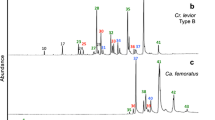Summary:
The discriminatory ability of the ant Manica rubida was tested using mixed species groups composed of M. rubida and Formica selysi. We recorded the response of M. rubida reared in homospecific or heterospecific groups towards postpharyngeal glandular secretions (applied on a nestmate) of F. selysi that originated from various homo- or heterospecific groups. The reaction of the ants depended largely on the source of the scent applied, and tends to suggest a hierarchical system for deciphering the odour. The ants exhibited a diminishing degree of aggression that corresponded to an increase in the degree of odour familiarity. The most aggressive encounters were manifested when M. rubida ants from homospecific colonies were exposed to the glandular secretions of F. selysi ants from homospecific colonies. A lesser degree of reaction was noted when M. rubida from mixed species were tested with similar alien secretions. At the other extreme, heterospecific M. rubida ants exposed to a completely familiar signal (that of F. selysi nestmates) did not elicit any overt aggression. Intermediate reactions occurred when the secretion was only partially familiar. The introduction of completely alien elements e.g., the occurrence of alkenes and alkadienes characteristic to F. selysi but barely present in M. rubida from homospecific colonies, appeared to elicite the highest aggression. On the other hand, in M. rubida from heterospecific groups, all the signal elements were familiar but the overall composition deviated from the aquired template. We hypothesize that the deciphering of the odour may be hierarchical and that the template to which the odour is compared is acquired. Moreover, since the odour is dynamic, template plasticity must follow. Acquisition of the template is not a permanent event, but has to be reinforced via constant perception of nestmates' odours.
Similar content being viewed by others
Author information
Authors and Affiliations
Additional information
Received 23 October 1996; revised 26 January 1997; accepted 6 February 1997
Rights and permissions
About this article
Cite this article
Errard, C., Hefetz, A. Label familiarity and discriminatory ability of ants reared in mixed groups. Insectes soc. 44, 189–198 (1997). https://doi.org/10.1007/s000400050040
Published:
Issue Date:
DOI: https://doi.org/10.1007/s000400050040




